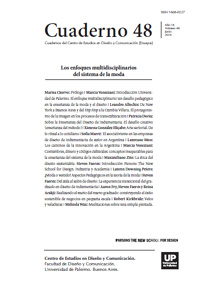Achieving the new graduate dream: building sustainable business success at a small scale
Abstract
Fashion graduates are increasingly electing to direct their professional
ambitions towards small business entrepreneurship rather than traditional corporate
modes of practice. These fashion entrepreneurs must engage with business development
and management, skills that are normally not required of designers within the corporate
business model. How can the fashion entrepreneur of the future be prepared? What
knowledge and skills are required for becoming a fashion entrepreneur? Is there a disconnect between what graduating fashion entrepreneurs think they need to know, and
the practices that will actually best prepare them for starting and maintaining a fashion
design start-up business? The authors summarize fashion entrepreneurship in New York
City, discuss the logistics of the globalized mass-market, and the current challenges in
fashion design pedagogy with regard to preparation for this global fashion context. The
authors then highlight the counter-trend of the small-scale local venture. Finally they
propose broad strategies directed toward the fashion entrepreneur who wishes to create a
sustainable small-scale fashion business venture in New York
References
Choi, T-M., Liu, S-C., Tang, CS, & Yu, Y. (2011). A cross-cluster and cross-region analysis of fashion brand extensions. Journal of the Textile Institute, 102 (10), 890-904.
Dean, T.J., Brown, R.L., & Bamford, C.E. (1998). Differences in large and small firm res- ponses to environmental context: strategic implications from a comparative analysis of business formations. Strategic Management Journal, 19, 709-728.
Elkington, J. (1997). Canibals with forks: The triple bottom line of 21st century business. Ox- ford: Capstone Publishing Ltd.
Garengo, P., Biazzo, S., & Bititci, U.S. (2005). Performance measurement systems in SMEs: A review for a research agenda. International Journal of Management Review, 7, 25-47.
Ha-Brookshire, J. & Dyer, B. (2008). Framing a descriptive profile of a transformed apparel industry: Apparel import intermediaries in the United States. Journal of Fashion Marketing and Management, 13 (2), 161-178.
Larocca, A. (2003, June 23). Two stylish. New York Magazine. Retrieved from http://nymag.
com/nymetro/shopping/fashion/features/n_8809/ Loschek, I. & Klose, S. (2007). Fashion shapes Europe. Culture Report Progress Europe, 1.
Retrieved from http://www.ifa.de/pdf/kr/2007/kr2007_en.pdf Marshall, T. (2009, January). Designing design education. Form, 224. Retrieved from http: //www.icograda.org/education/education/articles1397.htm Murphy, G.B., Trailer, J.W., & Hill, R.C. (1996). Measuring performance in entrepreneur- ship research. Journal of Business Research, 36, 47-67.
Okonkwo, U. (2007). Luxury fashion branding: trends, tactics, techniques, New York: Pelgra- ve Macmillan.
Parsons The New School for Design. (2011). Parsons The New School for Design career survey: Class of 2010. New York, NY: Office of Institutional Research.
Pink, D.H. (2005). A whole new mind: Why right-brainers will rule the future. New York: Riverhead Books.
Pinkerson, D. & Levin, M. (Producers), & Levin, M. (Director). (2009). Schmata: rags to riches to rags [Motion picture]. United States: Home Box Office Documentary Films.
Polegato, R. & Wall, M. (1980). Information seeking by fashion opinion leaders and follo- wers. Home Economics Research Journal, 8, 327-338.
Postrel, V. (2003). The substance of style. New York: HarperCollins Publishers.
Richardson, J. (1996). Vertical integration and rapid response in fashion apparel, Organiza- tion Science, 7, 400-412.
Save the Garment Center. (2012). Mission statement. Retrieved from http://savethegarment- center.org/about/ Salganik, M., Dodds, P., & Watts, D. (20006, February). Experimental Study of Inequality and Unpredictability in an Artificial Cultural Market. Science, 311(5762), 854-856.
Seigel, L. (2011, May 8). Why fast fashion is slow death for the planet. The Guardian, 35.
Taleb, N. (2007). The black swan: The impact of the highly improbable. New York: Random House.
The Municipal Art Society of New York. (2011, October 14). Fashioning the future: NYC’s garment district. Retrieved from http://mas.org/urbanplanning/garment-district/ Towers, J. (2005, July/August). Sustainable design. Print. Retrieve from http://www.euro- peanoutdoorgroup.com/downloads/sustainable-design/Sustainabledesign.pdf Unay, F.G. & Zehir, C. (2012). Innovation intelligence and entrepreneurship in the fashion industry, Procedia - Social and Behavioral Sciences, 41, 315-321.
Van Zandt, D. (2011). Inaugural Address. Retrieved from http://www.newschool.edu/lea dership/president/installation/ Vogue. (2013). Media press kit. [Data file]. Retrieved from http://www.condenast.com/ brands/vogue/media-kit/print/rates Watts, D. (2007, April 15). Is Justin Timberlake a product of cumulative advantage? The New York Times Magazine. Retrieved from http://www.nytimes.com/2007/04/15/magazine /15wwlnidealab.t.html?pagewanted=all&_r=0 Wilson, E. (2011, November 16). A marriage of economic convenience. The New York Ti- mes. Retrieved from http://www.nytimes.com/2011/11/17/fashion/designer-retailer-uni on-remains-lucrative.html?ref=fashion Wolff, L., Rhee, J. (2009, May). Is design the new liberal arts? Re:D, 26(6), 9-13.
Yu, W., Fan, J., Harlock, S.C., & Ng, S.P. (Eds.) (2006). Innovation and technology of women’s intimate apparel. Cambridge, England: Woodhead Publishing Limited.
Los autores/as que publiquen en esta revista ceden los derechos de autor y de publicación a "Cuadernos del Centro de Estudios de Diseño y Comunicación", Aceptando el registro de su trabajo bajo una licencia de atribución de Creative Commons, que permite a terceros utilizar lo publicado siempre que de el crédito pertinente a los autores y a esta revista.


